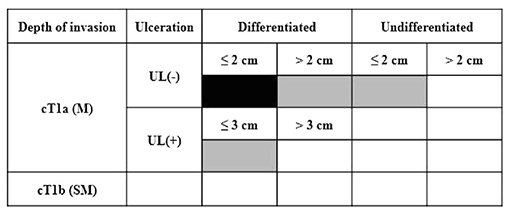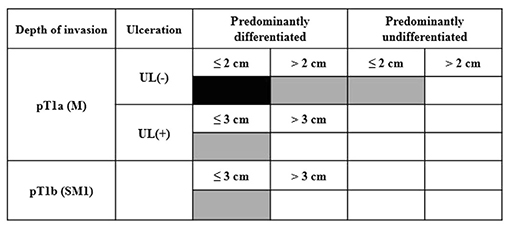Korean J Gastroenterol.
2018 Aug;72(2):79-82. 10.4166/kjg.2018.72.2.79.
Guidelines for Endoscopic Resection of Early Gastric Cancer: Comparison of Japanese and European Guidelines
- Affiliations
-
- 1Department of Internal Medicine, Korea University College of Medicine, Seoul, Korea. latyrx@korea.ac.kr
- KMID: 2418767
- DOI: http://doi.org/10.4166/kjg.2018.72.2.79
Abstract
- An endoscopic resection is performed widely and has been established as a standard therapeutic modality for the treatment of early gastric cancer (EGC) without lymph node metastasis. On the other hand, the selection of suitable patients by a thorough pre-procedural evaluation is mandatory for the successful management of EGC. Moreover, a clear and unified interpretation of a resected specimen and the definition of a curative resection is the mainstay for decision-making of an additional surgical resection and post-procedural surveillance schedule. This paper summarizes the key statements of Eastern (Japan Gastroenterological Endoscopy Society) and Western (European Society of Gastrointestinal Endoscopy) guidelines for an endoscopic resection of EGC, regarding the clinical staging and indication; pre-operative evaluation; definition of a curative resection; and post-procedural surveillance, focusing on the similarities and differences between the two guidelines.
MeSH Terms
Figure
Reference
-
1. Ono H, Yao K, Fujishiro M, et al. Guidelines for endoscopic submucosal dissection and endoscopic mucosal resection for early gastric cancer. Dig Endosc. 2016; 28:3–15.
Article2. Pimentel-Nunes P, Dinis-Ribeiro M, Ponchon T, et al. Endoscopic submucosal dissection: European Society of Gastrointestinal Endoscopy (ESGE) guideline. Endoscopy. 2015; 47:829–854.
Article3. Yamada T, Sugiyama H, Ochi D, et al. Risk factors for submucosal and lymphovascular invasion in gastric cancer looking indicative for endoscopic submucosal dissection. Gastric Cancer. 2014; 17:692–696.
Article4. Abe H. Advance and Retreat in ESD Indications in Early Gastric Cancer. USG-VI: Time to Look Back on ESGD for EGC. In : International Digestive Endoscopy Network 2018; 2018 Jun 29–Jul 1; Grand Hilton, Seoul, Korea. Seoul: Jin Publishing Co.;2018. p. 234–237.5. Nasu J, Doi T, Endo H, Nishina T, Hirasaki S, Hyodo I. Characteristics of metachronous multiple early gastric cancers after endoscopic mucosal resection. Endoscopy. 2005; 37:990–993.
Article6. Nakajima T, Oda I, Gotoda T, et al. Metachronous gastric cancers after endoscopic resection: how effective is annual endoscopic surveillance? Gastric Cancer. 2006; 9:93–98.
Article7. Fukase K, Kato M, Kikuchi S, et al. Effect of eradication of Helicobacter pylori on incidence of metachronous gastric carcinoma after endoscopic resection of early gastric cancer: an open-label, randomised controlled trial. Lancet. 2008; 372:392–397.
Article8. Yanaoka K, Oka M, Ohata H, et al. Eradication of Helicobacter pylori prevents cancer development in subjects with mild gastric atrophy identified by serum pepsinogen levels. Int J Cancer. 2009; 125:2697–2703.9. Maehata Y, Nakamura S, Fujisawa K, et al. Long-term effect of Helicobacter pylori eradication on the development of metachronous gastric cancer after endoscopic resection of early gastric cancer. Gastrointest Endosc. 2012; 75:39–46.
Article10. Kato M, Nishida T, Yamamoto K, et al. Scheduled endoscopic surveillance controls secondary cancer after curative endoscopic resection for early gastric cancer: a multicentre retrospective cohort study by Osaka University ESD study group. Gut. 2013; 62:1425–1432.
Article11. Choi IJ, Kook MC, Kim YI, et al. Helicobacter pylori therapy for the prevention of metachronous gastric cancer. N Engl J Med. 2018; 378:1085–1095.
Article
- Full Text Links
- Actions
-
Cited
- CITED
-
- Close
- Share
- Similar articles
-
- Endoscopic Submucosal Dissection in the Treatment of Patients With Papillary Early Gastric Cancer
- A Comprehensive and Comparative Review of Global Gastric Cancer Treatment Guidelines
- A Comprehensive and Comparative Review of Global Gastric Cancer Treatment Guidelines: 2024 Update
- Endoscopic Resection of Undifferentiated Early Gastric Cancer
- Helicobacter pylori Eradication in Patients Undergoing Gastrectomy: Diagnosis and Therapy



